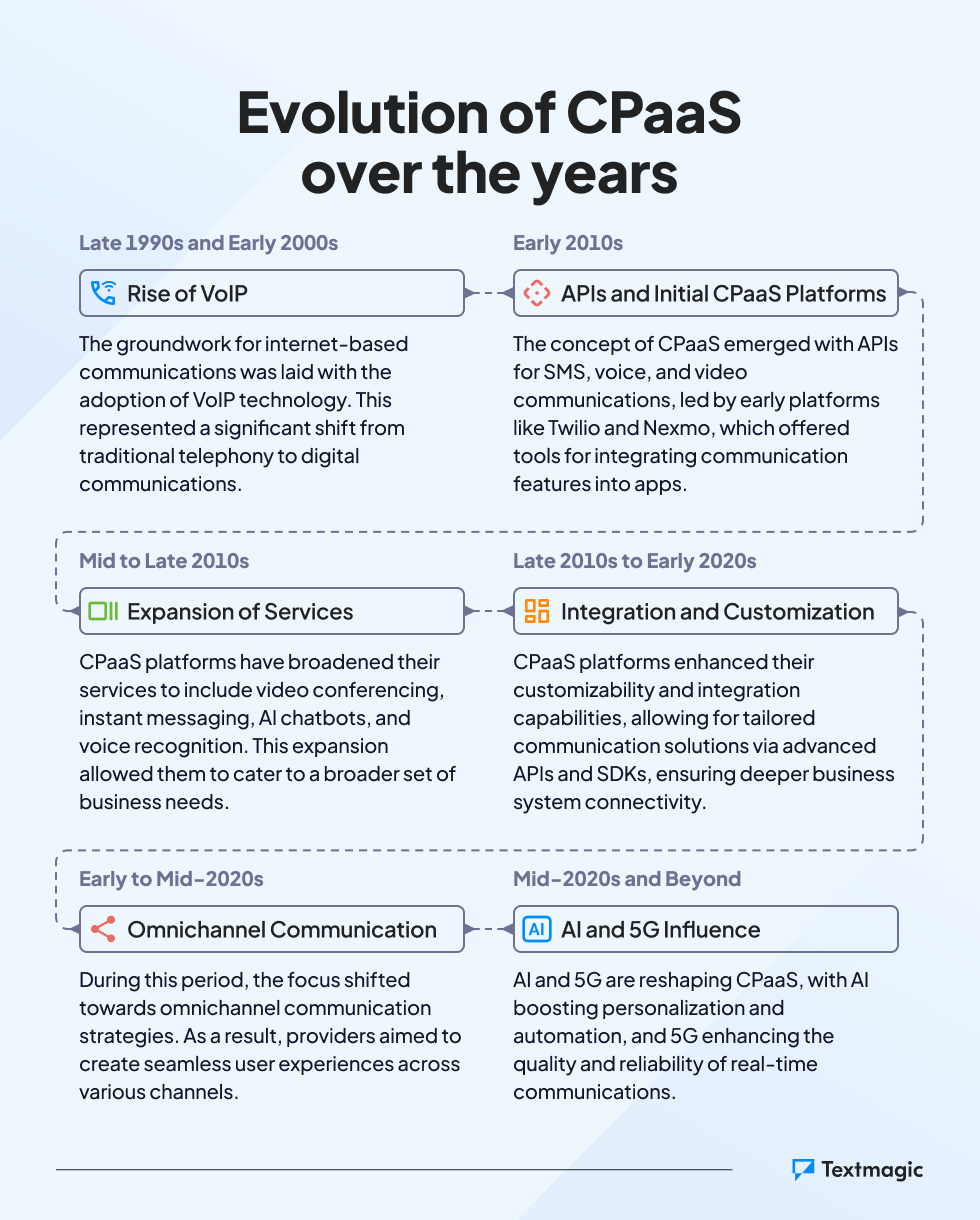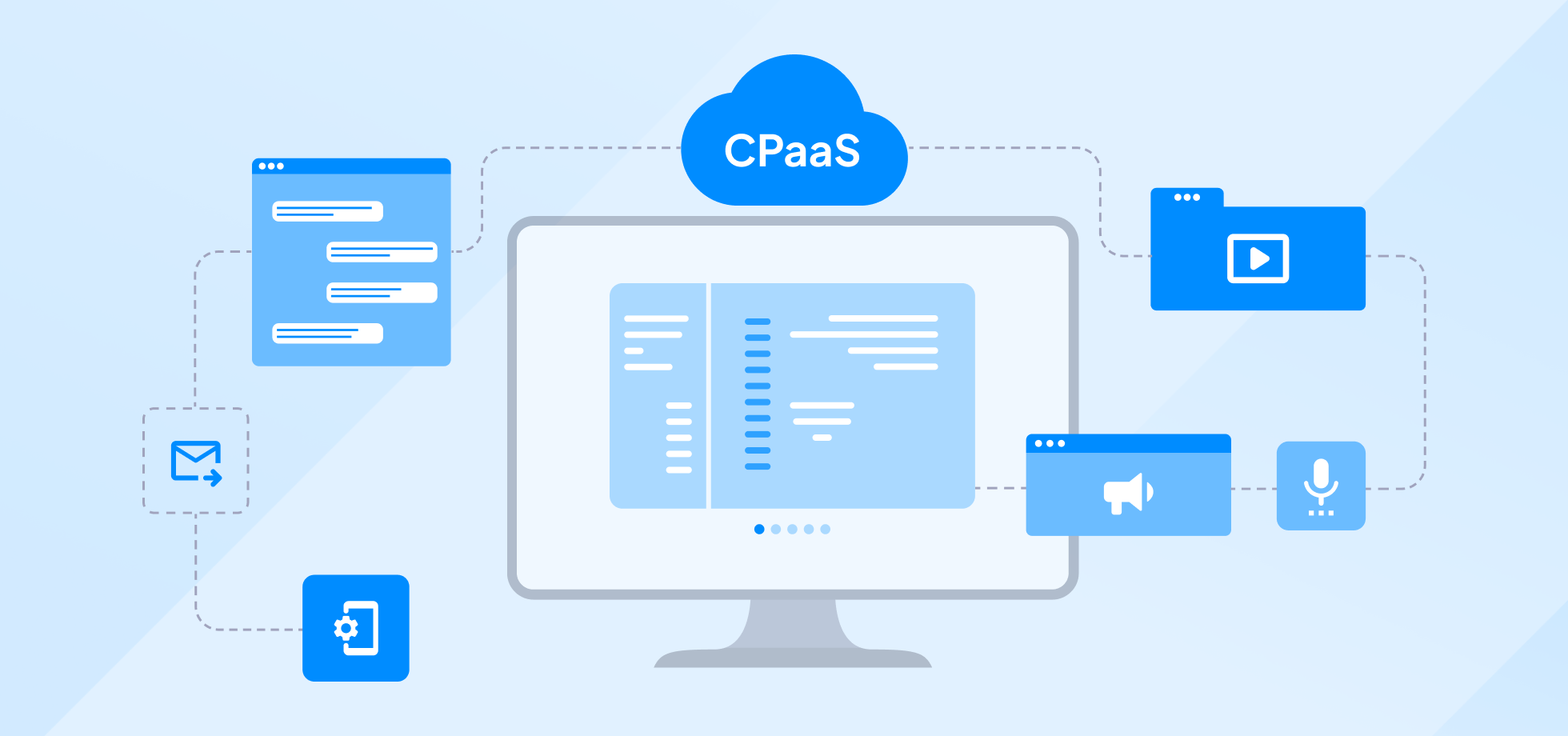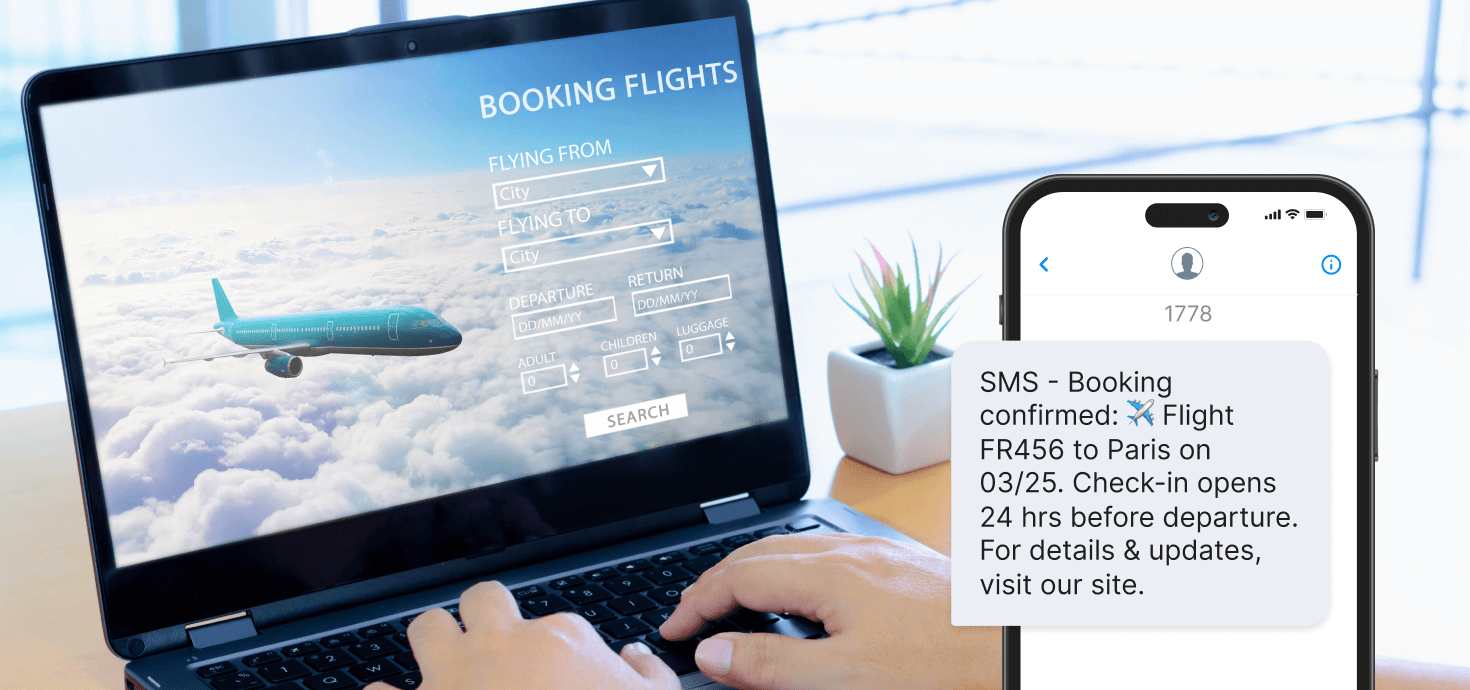
Communications Platform as a Service (CPaaS) is crucial for expanding businesses that leverage cloud technologies and seek to tailor their communications framework.
But what is CPaaS, and how does it work? Contrary to virtual phone systems managed by VoIP providers, CPaaS capabilities demand coding from the ground up. This article will cover the CPaaS definition, architecture, features, and main benefits. Let’s begin.
What is CPaaS?
CPaaS is a cloud-based solution that empowers businesses to embed voice, video, and messaging functionalities directly into their applications. This eliminates the need for developing standalone communication systems, streamlining the integration of real-time interactions (RTC) within existing digital ecosystems.
An instance of this would be adding a support chat box to your website with the help of a CPaaS service provider.
As a subset of PaaS (Platform-as-a-Service), CPaaS is a great way for brands to select specific communication channels to add to their suite of business applications. Popular examples include texting, voice, and messaging apps.
As opposed to Unified Communications-as-a-Service (UCaaS), which delivers an all-in-one, ready-to-deploy suite encompassing phone service, video meetings, and call recording, CPaaS provides a customizable blank canvas.
With a comprehensive toolkit of communication APIs, businesses can tailor features such as telephony and messaging to fit seamlessly into their existing software.
CPaaS evolved from the days of early VoIP (Voice over Internet Protocol), launching in the 2010s with APIs for basic communications. As illustrated below, it quickly expanded to include video, AI, and omnichannel features, becoming highly customizable to suit companies of all sizes.

How does CPaaS work?
Five main components make up the architecture of a Communications Platform as a Service:
- Cloud infrastructure
This is the foundation of CPaaS, consisting of servers, storage, and networking resources hosted in the cloud. It provides the necessary computing power and connectivity to support various communication services.
- CPaaS API
APIs serve as the bridge between the cloud and the CPaaS integration. They allow developers to add communications services to a company’s business apps without additional backend infrastructure.
- Application layer
At this level, different types of applications utilize the CPaaS API to integrate communication capabilities. Common examples include mobile apps, web apps, or custom software.
- Integrations via SDK
Developers create integrations that offer communication capabilities through the CPaaS SDKs (software development kits). These enable better customer engagement, internal communication, or even automated notifications based on a specific flow.
- Communication services
Through CPaaS, business apps can sport a variety of communication services, including text messaging, voice calls, and video calls. Advanced features like chatbots or AI-driven customer service assistants are also in the realm of possibility.
Simply put, CPaaS leverages cloud infrastructure via APIs, enabling developers with SDKs to integrate RTC services into applications. This architecture allows businesses to add communication functionalities to existing software.

Core features of CPaaS
There are many providers in the CPaaS market, each with its own product and capabilities. However, we can identify a few key features that pertain to this type of service. Here’s an overview.
Text messaging and apps
Messaging is the cornerstone of CPaaS. With it, businesses can send and receive text and multimedia messages or implement chats within their apps and websites.
This is beneficial in many scenarios, ranging from marketing campaigns to customer support interactions. Texts and chats can even be used for security procedures, such as two-factor authentication.
CPaaS platforms are evolving to incorporate 10DLC services designed to comply with new carrier regulations and standards in the United States. This alignment ensures businesses can send A2P messages with confidence, knowing they adhere to regulatory requirements and avoid penalties or filtering.
Voice and video communications
Voice and video communications, enhanced by the integration of call masking and cloud telephony, represent key features offered by CPaaS providers.
These providers enable the seamless incorporation of voice and video capabilities into business apps or websites. This includes everything from simple voice calls to comprehensive video conferencing features.
Thus, companies can easily entertain direct contact lines with customers regardless of their location. Communication among team members also benefits from this feature.
RTC powered by WebRTC
The real-time communication capabilities of CPaaS are powered by WebRTC technology. It allows web pages and mobile apps to support peer-to-peer communication directly through mutual file sharing, thus eliminating the need to install plugins or other native software.
This enables users to engage in live audio and video chats directly from their web browsers or mobile apps.
On-demand SIP trunking
Some CPaaS providers offer on-demand Session Initiation Protocol (SIP) trunking. This feature allows businesses to replace traditional phone lines with internet-based voice communications.
With SIP trunking, companies can scale their voice communications flexibly, connect with global telephony networks, and integrate voice services.
Integration via APIs
The true power of CPaaS lies in APIs, which allow for the seamless integration of communication features into existing business systems. They enable developers to customize and automate communications based on specific business needs and workflows.
CPaaS API integration ensures businesses can enhance their applications with communication features without disrupting their operations.
Benefits of CPaaS for businesses
Using a CPaaS solution for your business has several benefits regarding integration, engagement, and overall cost. Here are the main ones:
- Scalable architecture. CPaaS allows businesses to scale their communication capabilities and match demand without significant infrastructure investments.
- Quick integration. The service enables quick integration of communication features, reducing development time considerably.
- Enhanced customer engagement. Integrating varied communication channels into business apps enhances the customer experience with personalized interactions.
- Cost efficiency. The pay-as-you-go pricing model of CPaaS reduces upfront costs associated with communication infrastructure. Businesses with pre-negotiated rates or specific service agreements with carriers can utilize CPaaS’s Bring Your Own Carrier (BYOC) option to maintain these benefits.
- Innovation and customization. APIs allow for the development of tailored communication solutions, fostering innovation and providing a competitive advantage.
- Inbuilt security and compliance. CPaaS providers generally ensure their platforms comply with relevant regulations and offer robust security features.
CPaaS use cases
There are several CPaaS use cases across several sectors worth mentioning. We’ve explored some of the most prolific examples below.
Retail and eCommerce
CPaaS can help businesses enhance the shopping experience through personalized customer interactions.
Retailers can send custom messages, promotions, and updates through texting and chat APIs based on customer preferences and shopping history. This includes targeted offers, back-in-stock notifications, or exclusive deals.

Companies can also use CPaaS technology to send real-time texts about order status, shipping updates, and delivery confirmations. You can even go as far as to offer video consultations for high-value products, allowing customers to get a live demo.
Customer service
CPaaS solutions allow businesses to streamline the customer service process, reducing response times and providing 24/7 support. This is possible through AI-powered chatbots that can provide instant replies to FAQs, process orders, and route complex issues to agents.
Other CPaaS use cases for customer service consist of call queue management and automated feedback collection after a support interaction.

CPaaS platforms enable businesses to integrate Direct Inward Dialing (DID) numbers into their communication strategies, offering customers direct and personal lines to specific departments or personnel. This setup allows for more targeted and efficient customer service experiences.
In addition to these, businesses can also implement interactive voice responses for calls, which can identify the customer’s needs before routing them to a customer support agent.
Healthcare
Using a Communication Platform as a Service in the healthcare sector adds telehealth services and patient reminders to the process of servicing patients.
Hospitals and clinics can integrate high-quality video conferencing capabilities into their apps or websites, enabling doctors to conduct remote patient consultations.

Encryption APIs can simultaneously secure video or voice calls and text messages. This ensures compliance with local regulations pertaining to the healthcare sector, such as HIPAA in the U.S.
In terms of patient reminders, healthcare providers can use CPaaS to automate several types of notifications, such as:
- appointment reminders
- vaccination reminders
- screening reminders
- medication schedules
- follow-up care regimens
Finance
In the finance sector, CPaaS can help organizations increase transaction security. The most common way to do this is through two-factor authentication via text or voice calls. This helps verify transactions and account logins, adding another layer of security to the operation.

With a Communications Platform as a Service, businesses can also set up automated alerts for each transaction, allowing customers to verify the activity immediately. Plus, using this type of service also comes with a layer of encryption that further protects financial information.
Moreover, organizations can also set up automated fraud alerts. These alerts prompt customers to confirm or deny the transaction in a message or call, ensuring that no malicious activity passes through the cracks.
Travel
The CPaaS model can offer the travel sector a powerful toolkit to enhance customer experiences and streamline operations through scalable voice and messaging capabilities. In this case, the most popular integrations are booking confirmations for hotels or flights.

Furthermore, customers can receive updates via text or call for:
- flight changes
- hotel booking statuses
- transportation arrangements
- travel and health advisories
- visa requirements
With CPaaS, businesses in the travel sector can even go one step further and automate check-ins for flights or accommodations—all through SMS or voice calls. This reduces wait times and increases customer satisfaction.
Education
CPaaS solutions can bring a versatile approach to the education sector, facilitating remote learning and streamlining administrative communication.
A Communications Platform as a Service can help schools and other educational institutions create a well-oiled virtual classroom environment. This is firstly achieved by integrating video conferencing capabilities into learning management systems (LMS).

CPaaS can help schools create real-time collaboration tools via API and send out reminders for upcoming assignments, deadlines, and feedback. This helps students and teachers stay on top of the curriculum without attending in-person classes.
Educational institutions can also leverage messaging apps, texts, or voice calls to keep parents informed and disseminate important notices. Examples here include meeting reminders and emergency alerts.
How to choose the right CPaaS provider
When selecting the right CPaaS provider to suit your business needs, you should consider the following factors:
- Reliability – always look for providers with a proven track record of uptime and consistent performance.
- Scalability – the right CPaaS provider should be able to scale its services up or down based on your business needs.
- Feature set – depending on your needs, search for services with base capabilities only (messaging, voice, video), or that also include more advanced functionalities (AI-driven services).
- Customer support – the technical and customer support level is crucial to how well your business will integrate with CPaaS technology.
- Compatibility – ensuring that CPaaS solutions can be easily integrated with your current business systems is the key to minimizing disruptions.
- Pricing model – go for transparent and flexible pricing models that align with your usage patterns and budget.
You can choose from several worthwhile options in the industry. Some of the best CPaaS providers to consider are:
For a detailed comparison between them, check out our article on the top CPaaS vendors.
Conclusion
CPaaS has transformed business communications by providing flexible, scalable, and customizable solutions that integrate seamlessly into business apps. Its ability to offer real-time communication across various channels makes it a strategic choice for businesses.
As digital interactions continue to evolve, CPaaS is a pivotal tool for businesses aiming to stay ahead. With its technology under your belt, you can adapt to emerging trends and maintain a competitive edge in a dynamic market.
Related articles
Everything you need to know about process documentation (free templates included)
It’s no secret that the most productive employees ar...
Push notifications best practices for successful marketing campaigns
On a daily basis, the average American receives 46 p...
Boost your SaaS revenue: Top 6 Pricing models & DIY templates
How much you charge for your service impacts how peo...
5 Ways to get the most out of your Textmagic trial
Not sure if business texting is right for you? Sign ...
10 Polite, but persuasive, cancellation email templates
Customer cancellations often come disguised as losse...




